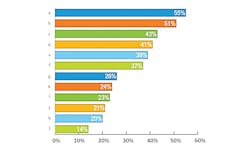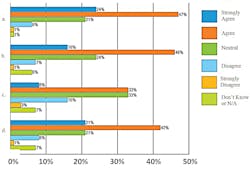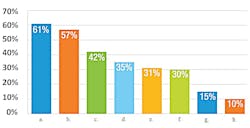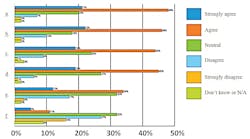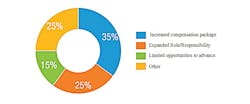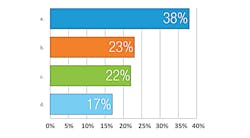The Pulse of the Engineer research report presents the answers obtained from 1,581 survey respondents. In the information below parentheses show the percentage of respondents for that statement. The job functions included:
- Design engineers (35%)
- Engineering consultants (14%)
- Individual contributors (30%)
- Managers or senior managers (24%)
Figure 1 provides a good indication of today’s engineering community. Three items stand out that indicate how engineers are surviving in a competitive environment.
- Engineers are required to do more with less (55%)
- Pace of engineering is constantly increasing (51%)
- Technology is improving productivity (43%)
Figure 1: What conditions do you believe accurately portray the situation at your company?
a. We are required to do more with less
b. Pace of engineering is constantly increasing
c. Technology is improving productivity
d. Pressure to cut costs is putting product quality/rework at risk
e. Pressure to meet deadlines is putting product quality/rework at risk
f. We lose specialized knowledge and senior expertise faster than we gain it
g. New hires are being added to handle additional work, not just to replace staff vacancies
h. Productivity is impacted because I have to informally train/advise new co-workers
i. It is harder to tap into institutional knowledge unless you have a mentor or internal network of contacts
j. Budgets are increasing
k. I am overwhelmed with information
l. Pressure to demonstrate credibility and competence due to perceived race/gender/age/culture/language skill differences
Engineers are under several pressures that impact their ability to perform their jobs because product development is going through some changes, as shown in Fig. 2:
- Designs are more complex/sophisticated (47%)
- Design cycles are shrinking (46%)
- There are more time-to-market pressures (42%)
Figure 2: Agree or disagree with the following statements about design/projects
a. Designs are more complex/sophisticated
b. Design cycles are shrinking
c. There are fewer design win opportunities
d. There are more time-to-market pressures
Workload in most cases depends on company size and the amount of work they have in-house. An indicator of this is the number of projects an engineer is working on, as shown in Fig. 3.
- The highest percentage is for 3-5 projects (42%)
- More than 20 projects was rare (2%)
- 1-2 projects (29%)
- 6-10 projects (22%)
Figure 3: Typically, how many projects are you working on concurrently?
Customer service/satisfaction was the most often cited objective used to measure a team or department’s performance. For companies with less than $10 million in revenue, customer satisfaction is the single most important performance target. For larger companies, the most important target is launch dates. Figure 4 lists the engineering evaluation factors for team/department performance:
- Customer service/satisfaction (61%)
- Product quality (57%)
- Meeting launch dates (42%)
- Product unit costs (35%)
Figure 4: What target goals/objectives are used to measure your team/department performance?
a. Customer service/satisfaction
b. Product quality
c. Launch dates
d. Product unit Costs
e. Product Development Budget
f. Revenue targets
g. Service/warranty costs
h. Other
Figure 5 lists the constraints that an engineer feels are jeopardizing a company’s productivity, innovation, and/or product quality. Respondents strongly agreed on these constraints.
- Resources/people constraints/shortage (48%)
- Talent/specialized knowledge shortage (46%)
- Budgetary constraints/shortage (44%)
- Project/product deadline/time constraints (45%)
Figure 5: Agree or disagree with the following: These constraints are jeopardizing my company’s productivity, innovation, and/or product quality
a. Resources/people constraints/shortage
b. Talent/specialized knowledge shortage
c. Budgetary constraints/shortage
d. Project/product deadline/time constraints
e. Constraints managing/accessing information
f. Constraints bridging race/gender/age/cultural context differences
The survey also looked at engineering workforce changes. When asked how the size of the company changed in the last two years, the response was as shown in Fig. 6.
- Stayed the same (37%)
- Increased (31%)
- Decreased (22%)
Figure 6: In the past two years how has the size of you company’s engineering workforce change?
During the past two years, employee losses have stayed the same for 41% to 53% regardless of natural turnover, retirement, or layoffs/downsizing, as shown in Fig. 7. This indicates relatively stable employment numbers in most companies. Even the effect of retirement only represented a 6% significant increase in employee losses, which was the same number for layoffs/downsizing.
Figure 7: In the past two years, how have employee losses in your company’s workforce changed?
a. Loss of employees has…
b. Loss of employees to natural turnover(severance, quit, dismissal) has …
c. Loss of senior employees to retirement has…
d. Loss of employees due to visa expirations or temporary workers has…
e. Loss of employees due to layoffs/downsizing has…
Figure 8 indicates the impact of the loss of key employees in a company, particularly those with considerable experience. The resulting knowledge and/or information losses, as expressed by engineers was:
- Very important (32%)
- Moderately important (27%)
- Slightly important (13%)
Figure 8: How important was knowledge and/or information loss as employees left the company?
When asked how likely would you be employed by the same company five years from now, the results in Fig. 9 were indicated. Over 50% felt that they would probably be working for the same company. The percentages were:
- Very likely (34%)
- Moderately likely (27%)
- Slightly likely (14%)
Figure 9: Estimate how likely you are to be employed at the same company five years from now
The primary reason for engineers to leave their current role yielded the results shown in Fig. 10. The main reason for leaving the engineering workforce was to retire.
- Retire (33%)
- Move to a different company (25%)
- Work for the competition (20%)
Figure 10: If you were to leave your current role, what do you anticipate would be the primary reason?
An engineer’s years of experience obviously influences the desire to retire, as given by the number of years of experience of today’s engineers. According to this report, 47% of today’s engineers have 30 or more years on the job. Who will take their place? Are there enough perspective engineers in colleges?
- In engineering for 30 or more years (47%)
- For 20-29 years (22%)
- For 10-19 years (17%)
Increased monetary compensation is still the primary reason for changing jobs, although job satisfaction comes in second place according to the survey results in Fig. 11:
- Increased compensation package (35%)
- Expanded role/responsibility (25%)
- Limited opportunities to advance (15%)
Figure 11: Please indicate your reason for moving to another company
In Fig. 12 the engineers in the survey described their present work environment. It’s hard to tell if the respondents were really describing how they felt about the company they worked for or were just telling the person they talked to what they wanted hear.
- I am loyal to my company, as they respect my work and encourage me to come up with unique and creative ways to solve problems. My professional goal is to work on new challenges with colleagues I respect. (38%)
- My peers would best describe me as curious, as I am always searching for new and innovative technologies. I have many ideas, and am not always shy about sharing them with my manager and my colleagues. (23%)
- Working fast and working hard is important to me, especially in light of more projects, shorter design cycles and an increased focus on reducing time to market. I am happiest managing people and projects. (22%)
- Although I am part of a team, I feel like I am often working alone. I don’t see myself as a decision maker, though I would like to move into a more substantial role as I gain experience. I may seem quiet, but it’s because I am not seeking glory. I just want to produce good work that gets noticed. (17%)
Figure 12: Which of the following statements closely describes you in your work environment?
a. I am loyal to my company, as they respect my work and encourage me to come up with unique and creative ways to solve problems. My professional goal is to work on new challenges with colleagues I respect.
b. My peers would best describe me as curious, as I am always searching for new and innovative technologies. I have many ideas, and am not always shy about sharing them with my manager and my colleagues.
c. Working fast and working hard is important to me, especially in light of more projects, shorter design cycles and an increased focus on reducing time to market. I am happiest managing people and projects.
d. Although I am part of a team, I feel like I am often working alone. I don’t see myself as a decision maker, though I would like to move into a more substantial role as I gain experience. I may seem quiet, but it’s because I am not seeking glory. I just want to produce good work that gets noticed.
The complete report is available for download here. Visit the Engineering360 website at http://www.globalspec.com/.

